Estimation of Evapotranspiration of a Jujube/Cotton Intercropping System in an Arid Area Based on the Dual Crop Coefficient Method
Abstract
1. Introduction
2. Materials and Methods
2.1. Study Site
2.2. Study Design
2.3. Measurements
2.3.1. Crop Growth Indicators
2.3.2. Crop Evapotranspiration
2.3.3. Crop Yield
2.3.4. Meteorological Parameters
2.4. Calculation of Evapotranspiration Using the Dual Crop Coefficient Method
2.5. Parameter Correction for the Dual Crop Coefficient Method
2.6. Estimation of the Crop Coefficient under Compound Intercropping
2.7. Data Processing and Analysis
3. Results
3.1. Evaluation of Simulation Results in the Dual Crop Coefficient Method
3.1.1. Single-Crop Jujube and Cotton
3.1.2. Jujube/Cotton Intercropping
3.2. Variation of Evapotranspiration in Single-Crop Jujube and Cotton
3.3. Yield of Single-Crop Jujube and Cotton
4. Discussion
5. Conclusions
Author Contributions
Funding
Conflicts of Interest
References
- Duan, Z.; Liu, T.; Zhang, Y.; Jiao, C.; Luan, P.; Yang, T.; Shi, S.; Tian, Y.; He, X.; Li, L.; et al. Formation and influencing factors of cotton yield in jujube cotton intercropping system. Agric. Res. Arid Reg. 2018, 36, 93–100. [Google Scholar]
- Vandermeer, J. The ecology of intercropping. Trends Ecol. Evol. 1989, 4, 324–325. [Google Scholar]
- Ofori, F.; Stern, W.R. Cereal-legume intercropping systems. Adv. Agron. 1987, 41, 41–90. [Google Scholar]
- Wu, J.; Liu, W.; Chen, C. Can intercropping with the world’s three major beverage plants help improve the water use of rubber trees. J. Appl. Ecol. 2016, 53, 1787–1799. [Google Scholar] [CrossRef]
- He, C.; Meng, P.; Zhang, J.; Gao, J.; Sun, S. A Study on Water Use of Two Fruit Tree-Wheat Intercropping Systems in the Rocky Hilly Region of North China with Stable Carbon Isotope Technique. Sci. Silvae Sin. 2012, 48, 1–7. [Google Scholar]
- Ling, Q.; Gao, X.; Zhao, X.; Huang, J.; Li, H.; Li, L.; Sun, W.; Wu, P. Soil water effects of agroforestry in rainfed jujube (Ziziphus jujube, Mill.) orchards on loess hillslopes in Northwest China. Agric. Ecosyst. Environ. 2017, 247, 343–351. [Google Scholar] [CrossRef]
- Li, F.; Wang, L.; Wang, X.; Yao, B.; Lei, J. Optimal drip-irrigation amount improving cotton yield and land-use efficiency in jujube-cotton intercropping system of southern Xinjiang. Trans. Chin. Soc. Agric. Eng. 2014, 30, 105–114. [Google Scholar]
- Kool, D.; Agam, N.; Lazarovitch, N.; Heitman, J.L.; Sauer, T.J.; Ben-Gal, A. A review of approaches for evapotranspiration partitioning. Agric. For. Meteorol. 2014, 184, 56–70. [Google Scholar] [CrossRef]
- Monteith, J.L. Evaporation and environment. Symp. Soc. Exp. Biol. 1965, 19, 205–234. [Google Scholar]
- Shuttleworth, W.J.; Wallace, J.S. Evaporation from sparse crops-an energy combination theory. Q. J. R. Meteorol. Soc. 1985, 111, 839–855. [Google Scholar] [CrossRef]
- Allen, R.G.; Pereira, L.S.; Raes, D.; Smith, M. Crop evapotranspiration: Guidelines for computing crop water requirements. In FAO Irrigation and Drainage Paper 56; FAO: Rome, Italy, 1998. [Google Scholar]
- Gharsallah, O.; Facchi, A.; Gandolfi, C. Comparison of six evapotranspiration models for a surface irrigated maize agro-ecosystem in Northern Italy. Agric. Water Manag. 2013, 130, 119–130. [Google Scholar] [CrossRef]
- Zhang, B.; Liu, Y.; Xu, D.; Zhao, N.; Lei, B.; Ricardo, D.R.; Paula, P.; Teresa, A.P.; Luis, S.; Pereira, L.S. The dual crop coefficient approach to estimate and partitioning evapotranspiration of the winter wheat–summer maize crop sequence in North China Plain. Irrig. Sci. 2013, 31, 1303–1316. [Google Scholar] [CrossRef]
- Paço, T.A.; Ferreira, M.I.; Rosa, R.D.; Paredes, P.; Rodrigues, G.C.; Conceição, N.; Pacheco, A.; Pereira, L.S. The dual crop coefficient approach using a density factor to simulate the evapotranspiration of a peach orchard: SIMDualKc model versus eddy covariance measurements. Irrig. Sci. 2012, 30, 115–126. [Google Scholar] [CrossRef]
- Qiu, R.; Du, T.; Kang, S. Assessing the SIMDualKc model for estimating evapotranspiration of hot pepper grown in a solar greenhouse in Northwest China. Agric. Syst. 2015, 138, 1–9. [Google Scholar] [CrossRef]
- Ran, H.; Kang, S.; Li, F.; Tong, L.; Ding, R.; Du, T.; Li, S.; Zhang, X. Performance of AquaCrop and SIMDualKc models in evapotranspiration partitioning on full and deficit irrigated maize for seed production under plastic film-mulch in an arid region of China. Agric. Syst. 2017, 151, 20–32. [Google Scholar] [CrossRef]
- Fenner, W.; Dallacort, R.; Freitas, P.S.L.D.; Faria Júnior, C.A.; Carvalho, M.A.C.D.; Bariviera, G. Dual crop coefficient of common bean in Tangará da Serra, Mato Grosso. Rev. Bras. Eng. Agrícola Ambient. 2016, 20, 455–460. [Google Scholar] [CrossRef]
- A’Fifah, A.R.; Ismail, M.R.; Puteri, E.M.W.; Abdullah, S.N.A.; Kausar, H. Optimum Fertigation Requirement and Crop Coefficients of Chilli (Capsicum annuum) Grown in Soilless Medium in the Tropic Climate. Int. J. Agric. Biol. 2015, 17, 1560–8530. [Google Scholar]
- Paredes, P.; Pereira, L.S.; Rodrigues, G.C.; Botelho, N.; Torres, M.O. Using the FAO dual crop coefficient approach to model water use and productivity of processing pea (Pisum sativum L.) as influenced by irrigation strategies. Agric. Water Manag. 2017, 189, 5–18. [Google Scholar] [CrossRef]
- Li, F.; Ma, Y. Evapotranspiration Estimation of Summer Maize with Plastic Mulched Drip Irrigation Based on Dual Crop Coefficient Approach in Xinjiang. Trans. Chin. Soc. Agric. Mach. 2018, 49, 268–274. [Google Scholar]
- Zhao, P.; Li, S.; Li, F.; Du, T.; Tong, L.; Kang, S. Comparison of dual crop coefficient method and Shuttleworth–Wallace model in evapotranspiration partitioning in a vineyard of northwest China. Agric. Water Manag. 2015, 160, 41–56. [Google Scholar] [CrossRef]
- Wang, T. Research on the Interspecies Interaction of the Jujube-Cotton Planting Pattern in Arid Area; Xinjiang Agricultural University: Urumqi, China, 2016; pp. 9–10. [Google Scholar]
- Hong, M.; Zhu, H.; Mu, H.; Zhao, J.; Ma, Y. The water consumption rule of jujube trees under different emitter flow rate and irrigation quota. Agric. Res. Arid Reg. 2014, 1, 72–77. [Google Scholar]
- Zhang, Z.; Cai, H.; Yang, R.; Zhao, Y. Water requirements and crop coefficients of drip-irrigated crop under mulch in Minqin county oasis. Trans. Chin. Soc. Agric. Eng. 2004, 5, 97–100. [Google Scholar]
- Ma, J.; Liu, L.; Li, X.; Wang, J.; Yang, H. Evapotranspiration process of cotton field under mulched drip irrigation of oasis in arid region. Chin. J. Ecol. 2015, 4, 974–981. [Google Scholar]
- Li, L.; Zhao, X.; Gao, X.; Wu, P.; Li, H.; Ling, Q.; Sun, W. Soil water dynamic of rain-fed jujube (Ziziphus jujube) with stand age on Loess Plateau. Trans. Chin. Soc. Agric. Eng. 2016, 32, 145–152. [Google Scholar]
- Si, X.; Cai, H.; Zhao, L.; Yang, P.; Wang, Z. Estimation of greenhouse tomato evapotranspiration under deficit irrigation based on SIMDual Kc model. Trans. Chin. Soc. Agric. Eng. 2015, 31, 131–138. [Google Scholar]
- Ren, Y.; Wang, S.; Xie, L.; Dong, X. Effects of irrigation methods on water use efficiency and fruit quality of jujube in arid area. Trans. Chin. Soc. Agric. Eng. 2012, 28, 95–102. [Google Scholar]
- Ismail, S.M.; El-Nakhlawy, F.S. Measuring Crop Water Requirement and Crop Coefficient for Blue Panic Crop under Arid Conditions Using Draining Lysimeters. Irrig. Drain. 2018, 22, 220–231. [Google Scholar] [CrossRef]
- Hou, L.G.; Xiao, H.L.; Si, J.H.; Xiao, S.C.; Zhou, M.X.; Yang, Y.G. Evapotranspiration and crop coefficient of Populus euphratica Oliv forest during the growing season in the extreme arid region northwest China. Agric. Water Manag. 2010, 97, 345–356. [Google Scholar] [CrossRef]
- Wang, Z.; Xie, X.; Liu, G.; Ma, X. Jujube Drip Irrigation Water Consumption and Its Crop Coefficient in Oasis of Arid Region. Xinjiang Agric. Sci. 2015, 52, 675–680. [Google Scholar]
- Hu, Y.; Li, Y.; Zhang, Y. Experiment on Crop Coefficient and Water Requirement of Drip-irrigation Jujube in Loess Plateau of China. Trans. Chin. Soc. Agric. Mach. 2012, 43, 87–91. [Google Scholar]
- Yamanaka, T.; Takeda, A.; Shimada, J. Evaporation beneath the soil surface: Some observational evidence and numerical experiments. Hydrol. Process. 1998, 12, 2193–2203. [Google Scholar] [CrossRef]
- Torre-Sruiz, J.M.; Diaz-Espejo, A.; Perez-Martin, A.; Hernandez-Santana, V. Role of hydraulic and chemical signals in leaves, stems and roots in the stomatal behaviour of olive trees under water stress and recovery conditions. Tree Physiol. 2015, 35, 415. [Google Scholar] [CrossRef] [PubMed]
- Cai, Q.; Zhang, Y.; Sun, Z.; Zheng, J.; Wei, B.; Zhang, Y.; Liu, Y.; Feng, L.; Feng, C.; Zhang, Z.; et al. Morphological plasticity of root growth under mild water stress increases water use efficiency without reducing yield in maize. Biogeosciences 2017, 14, 3851–3858. [Google Scholar] [CrossRef]
- Brisson, N.; Bussière, F.; Ozier-Lafontaine, H.; Tournebize, R.; Sinoquet, H. Adaptation of the crop model STICS to intercropping. Theoretical basis and parameterisation. J. Theor. Biol. 2015, 37, 151–154. [Google Scholar] [CrossRef]
- Yang, C.H.; Chai, Q.; Huang, G.B. Root distribution and yield responses of wheat/maize intercropping to alternate irrigation in the arid areas of northwest China. Plant Soil Environ. 2010, 56, 253–262. [Google Scholar] [CrossRef]
- Miao, Q.F.; Rosa, R.D.; Shi, H.; Paredes, P.; Zhu, L.; Dai, J.; Goncalves, J.M.; Pereira, L.S. Modeling water use, transpiration and soil evaporation of spring wheat–maize and spring wheat–sunflower relay intercropping using the dual crop coefficient approach. Agric. Water Manag. 2016, 165, 211–229. [Google Scholar] [CrossRef]
- Abrisqueta, I.; Abrisqueta, J.M.; Tapia, L.M.; Munguía, J.P.; Conejero, W.; Vera, J.; Ruiz-Sánchez, M.C. Basal crop coefficients for early-season peach trees. Agric. Water Manag. 2013, 121, 158–163. [Google Scholar] [CrossRef]
- Zhao, N.; Liu, Y.; Cai, J.; Yu, F.; Li, C. Research on soik evaporation of summer maize by field measurement and model simulation. Trans. Chin. Soc. Agric. Eng. 2012, 28, 66–73. [Google Scholar]
- Kobayashi, T.; He, W.; Nagai, H. Mechanisms of evaporation from soil with a dry surface. Hydrol. Process. 2015, 12, 2185–2191. [Google Scholar] [CrossRef]
- Haboudane, D.; Miller, J.R.; Pattey, E.; Miller, J.R.; Pattey, E.; Zarco-Tejada, P.J.; Strachan, J.B. Hyperspectral vegetation indices and novel algorithms for predicting green LAI of crop canopies: Modeling and validation in the context of precision agriculture. Remote Sens. Environ. 2004, 90, 337–352. [Google Scholar] [CrossRef]
- Dente, L.; Rinaldi, M.; Mattia, F.; Satalino, G. Retrieval of Wheat LAI and Yield Maps from ENVISAT ASAR AP Data: Matera Case Study. In AIP Conference Proceedings; American Institute of Physics: Washington, WA, USA, 2006; Volume 852, pp. 250–257. [Google Scholar] [CrossRef]
- Baghestani, M.A.; Zand, E.; Soufizadeh, S.; Beygi, M.A. Evaluation of different empirical models of crop/weed competition to estimate yield and LAI losses from common lamb squatters (Chenopodium album L.) in maize (Zea mays L.). Pak. J. Biol. Sci. 2017, 10, 3752. [Google Scholar]
- Hammer, G.L.; Dong, Z.; McLean, G.; Donherty, A. Can Changes in Canopy and/or Root System Architecture Explain Historical Maize Yield Trends in the U.S. Corn Belt? Crop Sci. 2009, 49, 299. [Google Scholar] [CrossRef]
- Wu, M.; Zhang, W.; Zou, J.; Ma, C.; Han, W. Effects of drought stress on growth, physiological and biochemical parameters in fine roots of Quercus variabilis Bl. seedlings. Acta Ecol. Sin. 2014, 34, 4223–4233. [Google Scholar]
- Zhang, C.; Meng, P.; Zhang, J.; Wan, X. Effects of Intercropped Vigna radiata on root hydraulic Conductance and photosynthetic characteristics of Juglans regia seedlings. For. Res. 2016, 29, 110–116. [Google Scholar]
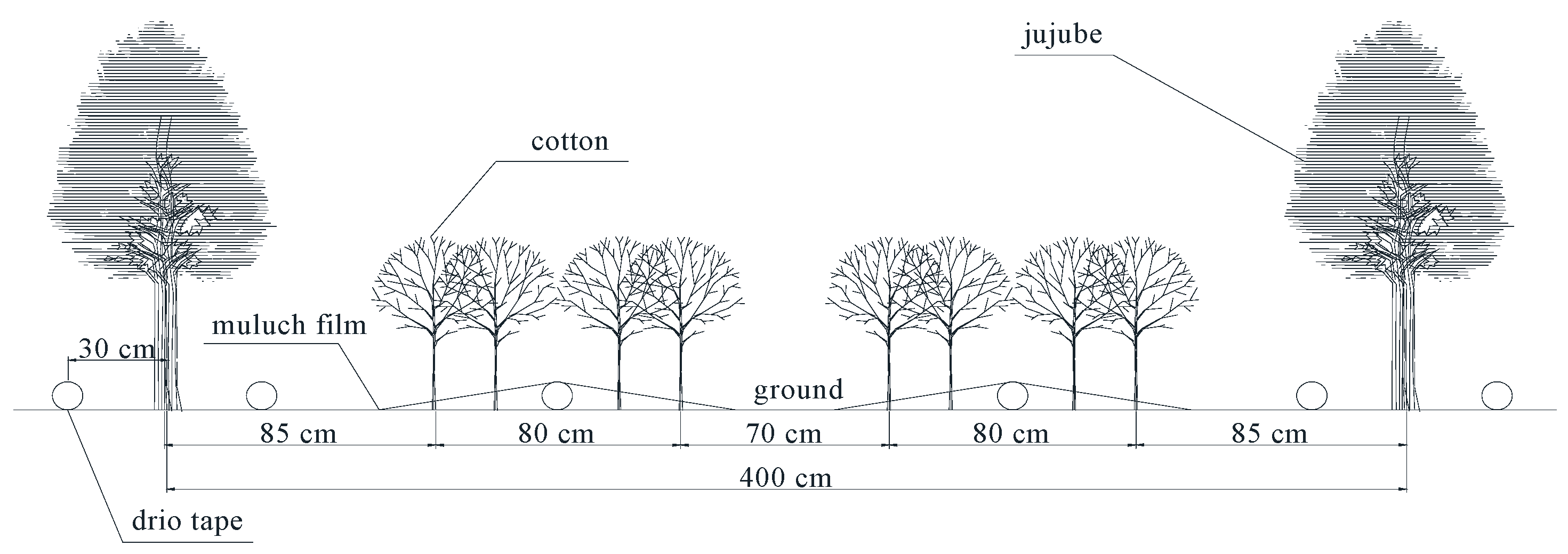
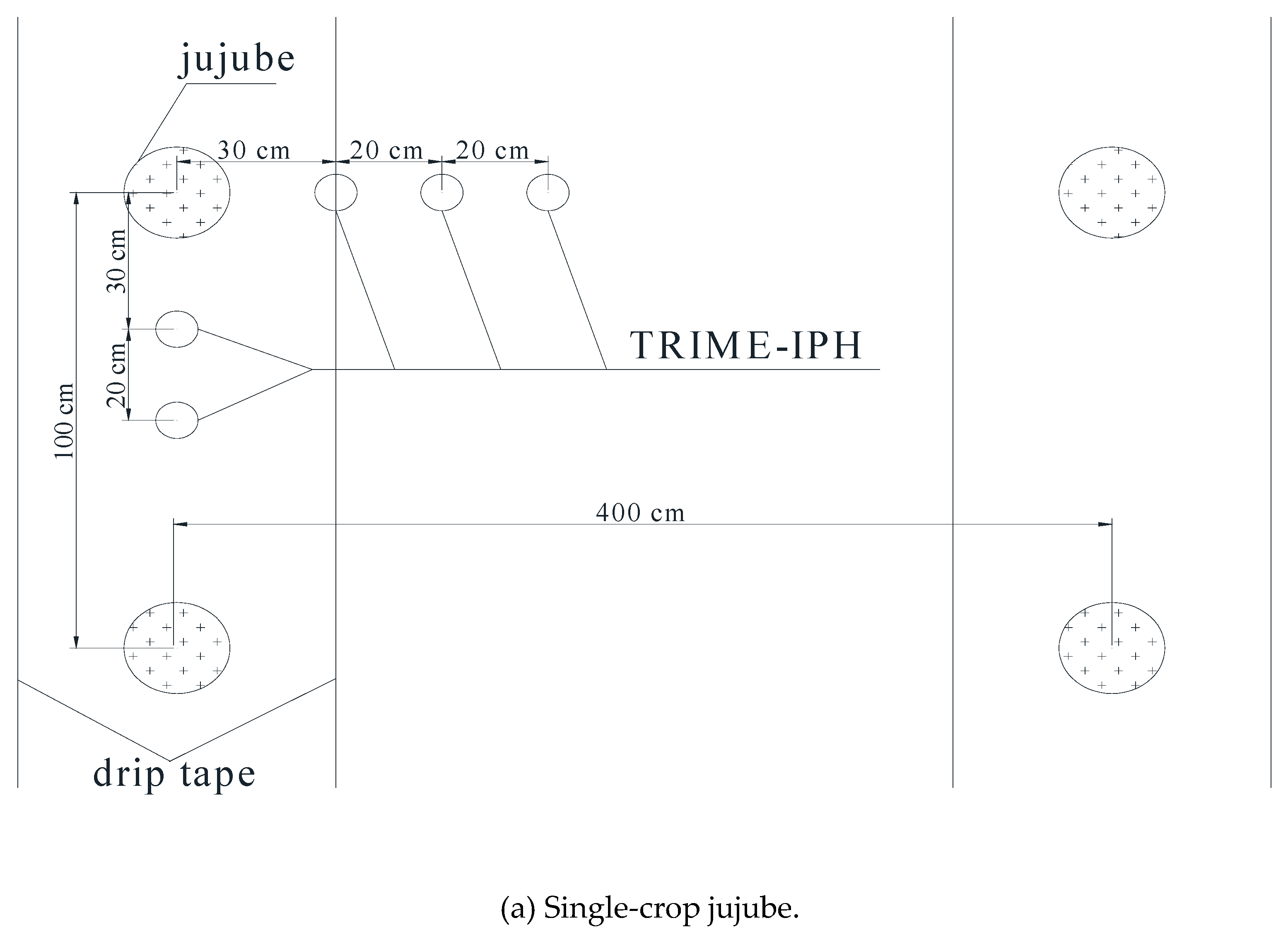
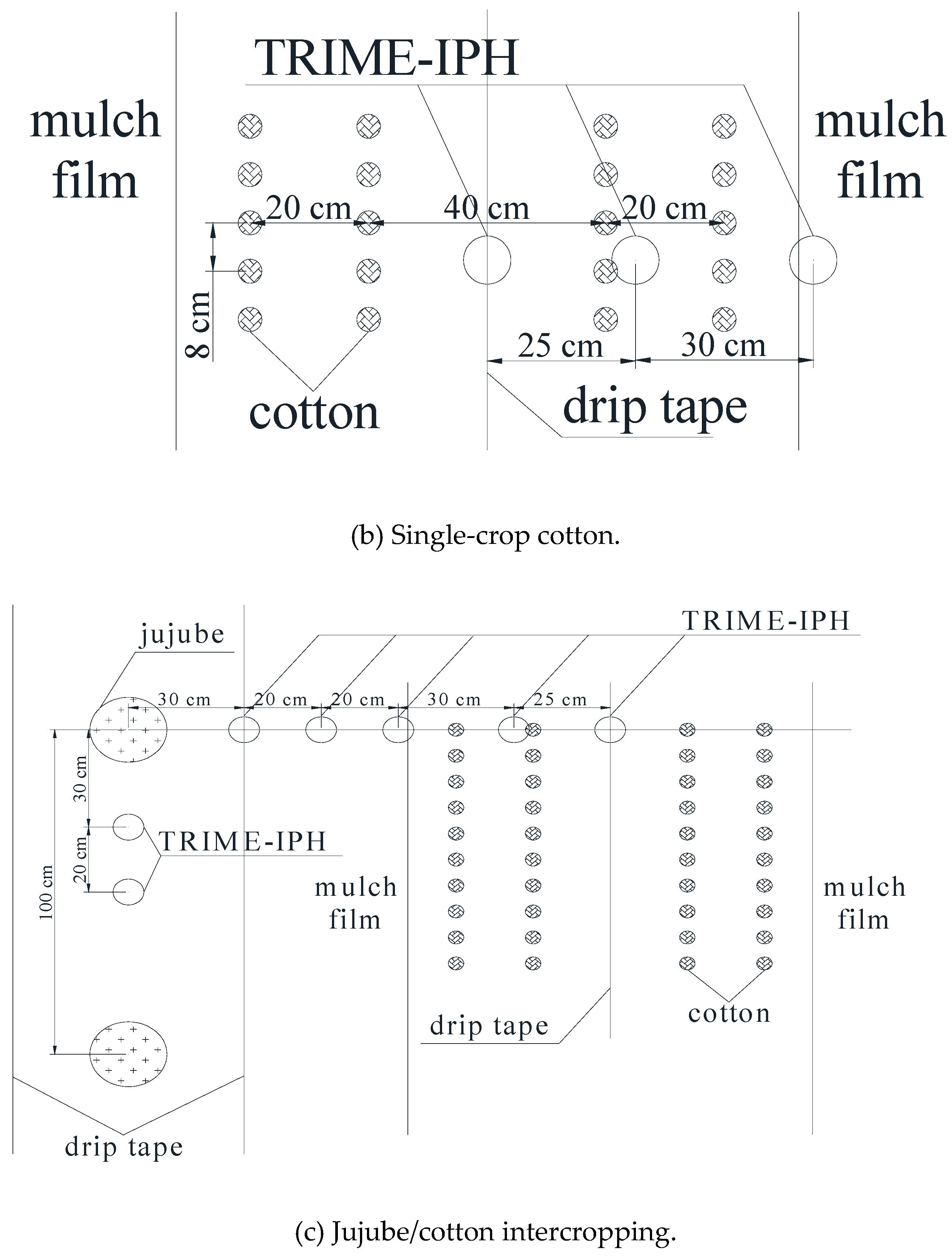
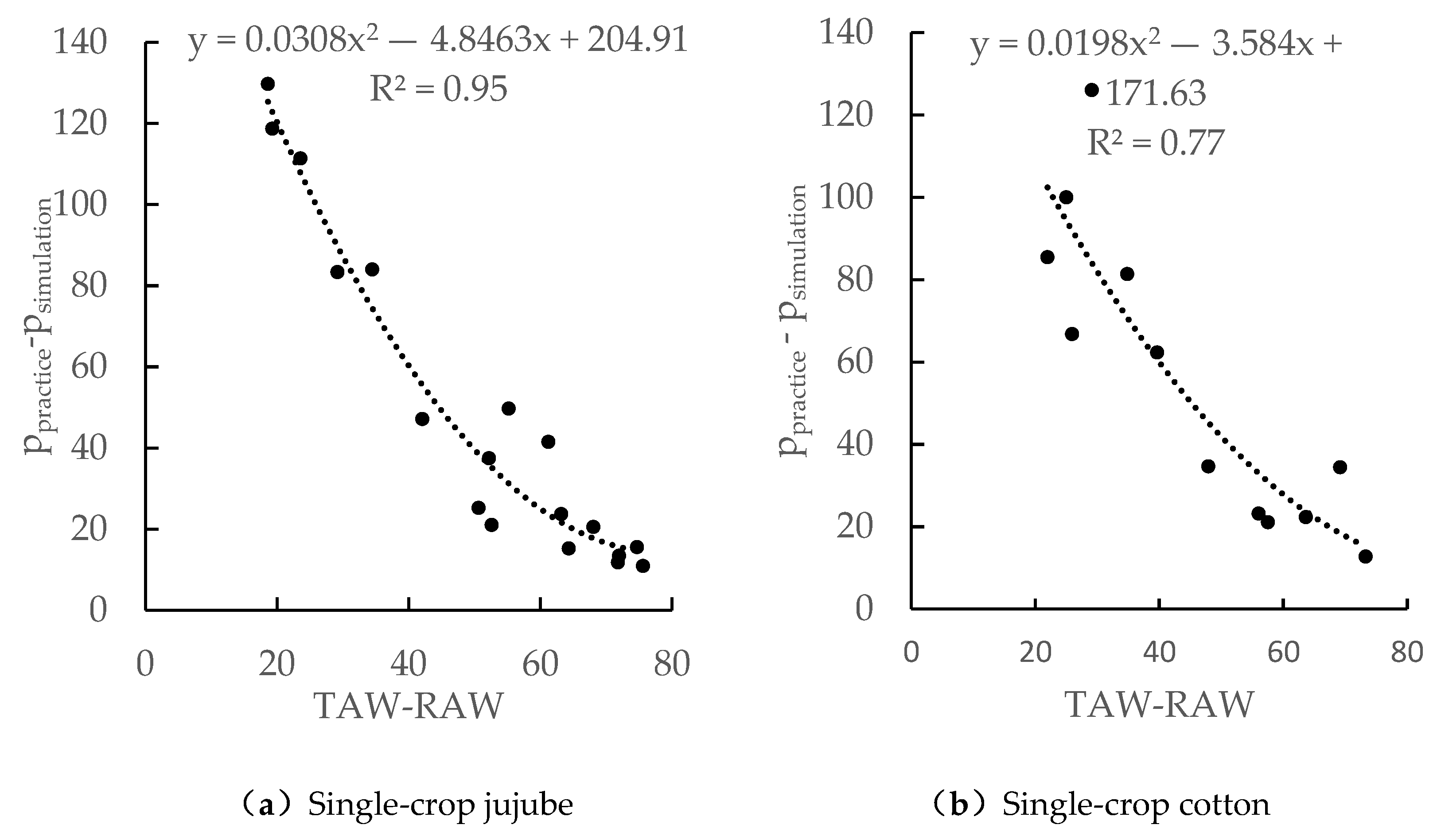
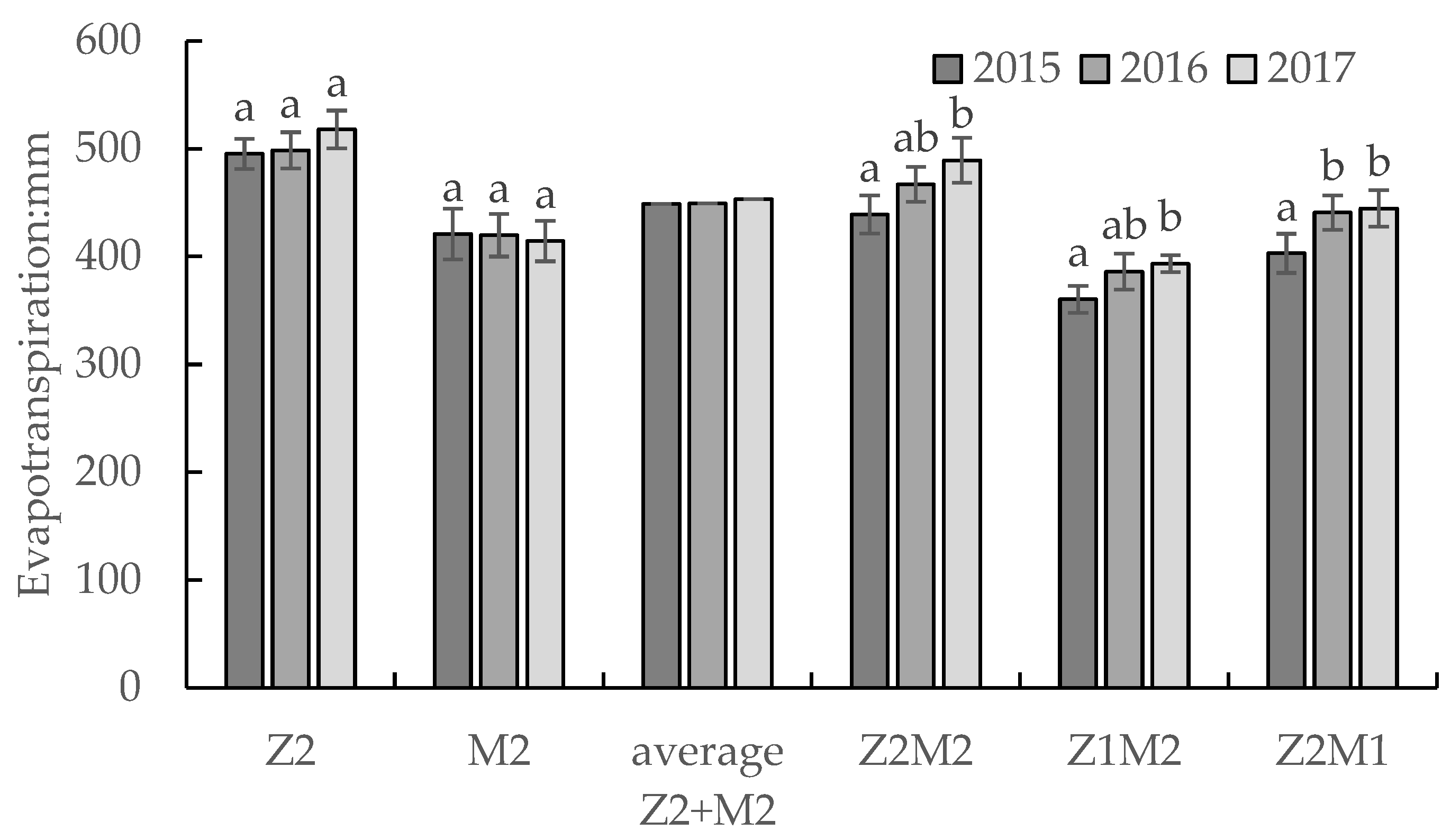
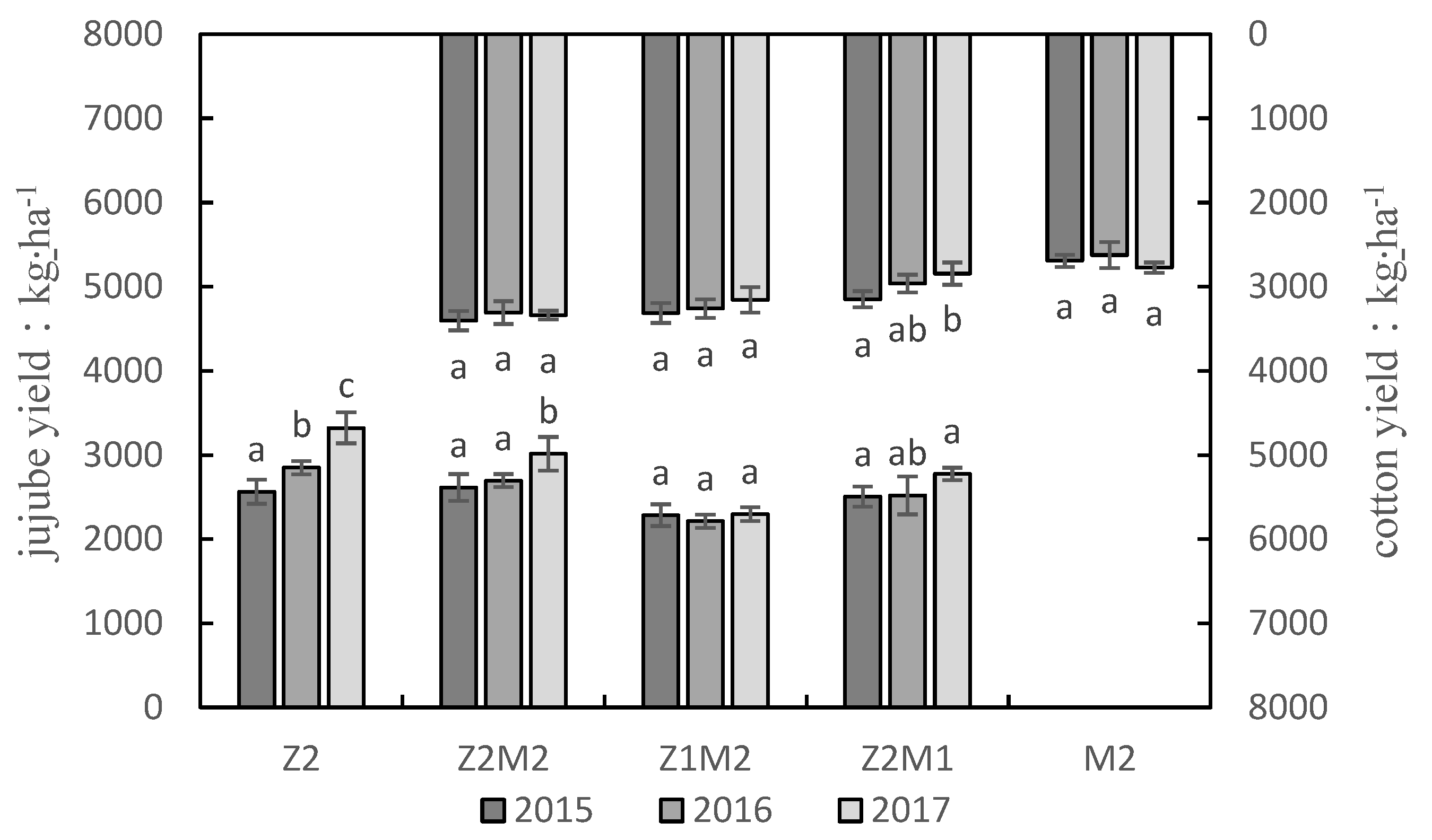
| Jujube | Growing Stage | Spring Irrigation | Sprout Leaves | Flowering | Fruit Setting | Fruit Enlargement | Fruit Mature | Whole |
| Irrigation quota | 2015–2016 | 40 mm | 70 mm | 140 mm | 70 mm | 105 mm | 35 mm | 460 mm |
| 2017 | 40 mm | 52 mm | 217 mm | 52 mm | 110 mm | 0 | 471 mm | |
| Cotton | Growing Stage | Spring Irrigation | Seedling | Budding | Flowering | Boll Setting | Boll Opening | Whole |
| Irrigation quota | 2015–2016 | 75 mm | 0 mm | 112.5 mm | 112.5 mm | 75 mm | 37.5 mm | 412.5 mm |
| 2017 | 75 mm | 0 mm | 128 mm | 84 mm | 98 mm | 30 mm | 415 mm |
| Relevant Parameters | Jujube | Cotton | |||
|---|---|---|---|---|---|
| Initial Values | Calibrated Values | Initial Values | Calibrated Values | ||
| Soil parameters | Evaporation depth of surface soil Ze: m | 0.10 | 0.15 | 0.10 | 0.15 |
| Total evaporative water in Surface Soil TEW: mm | 26.00 | 39.00 | 26.00 | 39.00 | |
| Surface evaporable water Volume REW: mm | 11.00 | 9.00 | 11.00 | 9.00 | |
| Crop parameters | Kcb-int | 0.45 | 0.40 | 0.15 | 0.20 |
| Kcb-mid | 0.85 | 1.00 | 1.15 | 1.20 | |
| Kcb-end | 0.60 | 0.70 | 0.50 | 0.50 | |
| Soil water consumption coefficientp | 0.50 | 0.50 | 0.65 | 0.40 | |
| Time | Z2 Treatment | M2 Treatment | |||||||
|---|---|---|---|---|---|---|---|---|---|
| Measurement | Simulation | Simulation (Revise) | Relative Error | Measurement | Simulation | Simulation (Revise) | Relative Error | ||
| 2015 | May | 109.75 ± 5.34 | 101.34 | 107.15 | −2.36% | 37.51 ± 2.88 | 38.69 | 38.69 | 3.13% |
| June | 126.37 ± 7.33 | 128.75 | 131.34 | 3.93% | 93.7 ± 4.24 | 84.61 | 84.61 | −9.70% | |
| July | 129.57 ± 5.85 | 124.22 | 125.52 | −3.12% | 133.63 ± 6.31 | 132.84 | 132.84 | −0.59% | |
| August | 88.74 ± 3.14 | 87.72 | 87.36 | −1.55% | 124.73 ± 8.73 | 115.02 | 120.69 | −3.24% | |
| September | 40.86 ± 3.46 | 35.49 | 37.69 | −7.74% | 31.32 ± 3.58 | 28.21 | 29.34 | −6.32% | |
| Total | 495.27 ± 13.96 | 477.53 | 489.07 | −1.25% | 420.89 ± 23.46 | 399.37 | 406.16 | −3.50% | |
| 2016 | May | 97.07 ± 4.24 | 93.61 | 94.61 | −2.54% | 36.76 ± 4.15 | 35.98 | 35.98 | −2.11% |
| June | 127.66 ± 2.99 | 123.55 | 123.69 | −3.11% | 100.78 ± 9.82 | 94.45 | 94.45 | −6.28% | |
| July | 137.14 ± 4.67 | 130.23 | 132.65 | −3.27% | 124.98 ± 8.03 | 126.94 | 126.94 | 1.56% | |
| August | 95.93 ± 6.54 | 97.17 | 97.87 | 2.02% | 121.5 ± 7.78 | 115.80 | 119.91 | −1.31% | |
| September | 40.73 ± 6.31 | 36.89 | 39.13 | −3.93% | 35.69 ± 3.76 | 32.06 | 33.34 | −6.59% | |
| Total | 498.53 ± 16.75 | 481.45 | 487.94 | −2.12% | 419.71 ± 19.82 | 405.22 | 410.62 | −2.17% | |
| 2017 | May | 109.86 ± 8.27 | 115.80 | 117.16 | 6.65% | 35.2 ± 1.75 | 38.04 | 38.04 | 8.06% |
| June | 135.41 ± 6.36 | 122.65 | 124.80 | −7.84% | 106.33 ± 12.72 | 111.24 | 111.24 | 4.62% | |
| July | 133.6 ± 6.48 | 125.67 | 129.27 | −3.24% | 127.71 ± 6.09 | 121.70 | 121.70 | −4.71% | |
| August | 99.62 ± 4.56 | 100.37 | 102.11 | 2.50% | 110.56 ± 4.62 | 109.36 | 113.27 | 2.45% | |
| September | 39.34 ± 2.32 | 32.08 | 35.29 | −10.31% | 34.54 ± 4.27 | 31.72 | 32.99 | −4.48% | |
| Total | 517.83 ± 17.56 | 496.57 | 508.63 | −1.78% | 414.34 ± 18.77 | 412.06 | 417.24 | 0.70% | |
| Year | Treatment | b | R2 | EF | RE | AE | RMSE | AAE |
|---|---|---|---|---|---|---|---|---|
| % | mm | mm·d−1 | mm·d−1 | |||||
| 2016 | Z2 | 0.955 | 0.894 | 0.887 | −2.123 | −10.583 | 0.411 | 0.337 |
| (calibration) | M2 | 0.933 | 0.911 | 0.897 | −2.166 | −9.091 | 0.463 | 0.367 |
| 2015 | Z2 | 1.016 | 0.871 | 0.846 | −1.253 | −6.205 | 0.453 | 0.356 |
| (verification) | M2 | 0.990 | 0.906 | 0.906 | −3.499 | −14.726 | 0.494 | 0.382 |
| 2017 | Z2 | 0.933 | 0.900 | 0.896 | −1.776 | −9.196 | 0.413 | 0.323 |
| (verification) | M2 | 0.957 | 0.908 | 0.905 | 0.700 | 2.899 | 0.445 | 0.299 |
| Year | Treatment | b | R2 | EF | RE | AE | RMSE | AAE |
|---|---|---|---|---|---|---|---|---|
| % | mm | mm·d−1 | mm·d−1 | |||||
| 2015 | Z2M2 | 0.975 | 0.849 | 0.828 | −1.753 | −7.695 | 0.448 | 0.356 |
| Z1M2 | 0.885 | 0.847 | 0.844 | 1.504 | 5.417 | 0.477 | 0.399 | |
| Z2M1 | 1.061 | 0.797 | 0.700 | 4.139 | 16.678 | 0.616 | 0.482 | |
| 2016 | Z2M2 | 0.999 | 0.841 | 0.805 | 2.881 | 13.447 | 0.472 | 0.338 |
| Z1M2 | 0.965 | 0.852 | 0.838 | 0.110 | 0.424 | 0.383 | 0.316 | |
| Z2M1 | 0.925 | 0.814 | 0.795 | 2.442 | 10.760 | 0.476 | 0.376 | |
| 2017 | Z2M2 | 0.944 | 0.814 | 0.830 | 0.433 | 2.118 | 0.623 | 0.424 |
| Z1M2 | 0.918 | 0.837 | 0.830 | 0.636 | 2.501 | 0.538 | 0.414 | |
| Z2M1 | 0.803 | 0.827 | 0.770 | 3.997 | 17.766 | 0.667 | 0.540 |
© 2020 by the authors. Licensee MDPI, Basel, Switzerland. This article is an open access article distributed under the terms and conditions of the Creative Commons Attribution (CC BY) license (http://creativecommons.org/licenses/by/4.0/).
Share and Cite
Ai, P.; Ma, Y. Estimation of Evapotranspiration of a Jujube/Cotton Intercropping System in an Arid Area Based on the Dual Crop Coefficient Method. Agriculture 2020, 10, 65. https://doi.org/10.3390/agriculture10030065
Ai P, Ma Y. Estimation of Evapotranspiration of a Jujube/Cotton Intercropping System in an Arid Area Based on the Dual Crop Coefficient Method. Agriculture. 2020; 10(3):65. https://doi.org/10.3390/agriculture10030065
Chicago/Turabian StyleAi, Pengrui, and Yingjie Ma. 2020. "Estimation of Evapotranspiration of a Jujube/Cotton Intercropping System in an Arid Area Based on the Dual Crop Coefficient Method" Agriculture 10, no. 3: 65. https://doi.org/10.3390/agriculture10030065
APA StyleAi, P., & Ma, Y. (2020). Estimation of Evapotranspiration of a Jujube/Cotton Intercropping System in an Arid Area Based on the Dual Crop Coefficient Method. Agriculture, 10(3), 65. https://doi.org/10.3390/agriculture10030065





